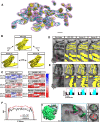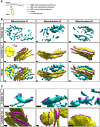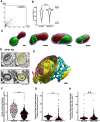An interactive deep learning-based approach reveals mitochondrial cristae topologies
- PMID: 37651352
- PMCID: PMC10470929
- DOI: 10.1371/journal.pbio.3002246
An interactive deep learning-based approach reveals mitochondrial cristae topologies
Abstract
The convolution of membranes called cristae is a critical structural and functional feature of mitochondria. Crista structure is highly diverse between different cell types, reflecting their role in metabolic adaptation. However, their precise three-dimensional (3D) arrangement requires volumetric analysis of serial electron microscopy and has therefore been limiting for unbiased quantitative assessment. Here, we developed a novel, publicly available, deep learning (DL)-based image analysis platform called Python-based human-in-the-loop workflow (PHILOW) implemented with a human-in-the-loop (HITL) algorithm. Analysis of dense, large, and isotropic volumes of focused ion beam-scanning electron microscopy (FIB-SEM) using PHILOW reveals the complex 3D nanostructure of both inner and outer mitochondrial membranes and provides deep, quantitative, structural features of cristae in a large number of individual mitochondria. This nanometer-scale analysis in micrometer-scale cellular contexts uncovers fundamental parameters of cristae, such as total surface area, orientation, tubular/lamellar cristae ratio, and crista junction density in individual mitochondria. Unbiased clustering analysis of our structural data unraveled a new function for the dynamin-related GTPase Optic Atrophy 1 (OPA1) in regulating the balance between lamellar versus tubular cristae subdomains.
Copyright: © 2023 Suga et al. This is an open access article distributed under the terms of the Creative Commons Attribution License, which permits unrestricted use, distribution, and reproduction in any medium, provided the original author and source are credited.
Conflict of interest statement
I have read the journal’s policy and the authors of this manuscript have the following competing interests: HK is an employee of LPIXEL Inc.
Figures







References
-
- Davies KM, Strauss M, Daum B, Kief JH, Osiewacz HD, Rycovska A, et al.. Macromolecular organization of ATP synthase and complex I in whole mitochondria. Proc Natl Acad Sci U S A. 2011;108(34):14121–6. Epub 2011/08/11. doi: 10.1073/pnas.1103621108 ; PubMed Central PMCID: PMC3161574. - DOI - PMC - PubMed
Publication types
MeSH terms
LinkOut - more resources
Full Text Sources
Research Materials

